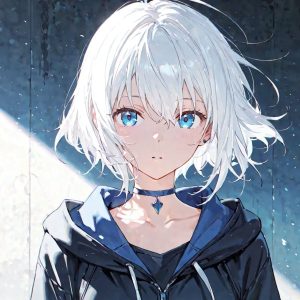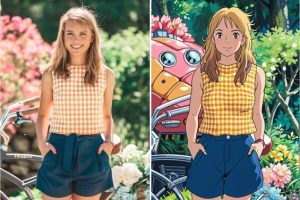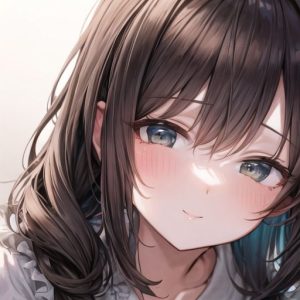Snapshots to Spirited Sketches Inside AI Image to Anime
The term that sends chills down the spine of art forums and fascinated fans is the ai image to anime. It is playful, surreal, and a little crazy-eyed. Anime fans are no longer content to merely watch the shows; they can now drop their selfies into any tech witch’s brews and have them pop out all huge-eyed and colorful, worthy of the scene they so desire to retexture. Need information on how this magic is done and why people stay gagging with more? Strap in–it will be a flickery, colorful ride.

The Secret Sauce: Learning Machines and Neural Networks
And now, without further ado, it is time to introduce the main actors in the magic of the AI to anime image conversion: neural networks. Consider them to be hyperactive interns, who are keen to acquire patterns based on the truckloads of images. These neural networks are trained on tens of thousands of real-face photographs, then hundreds of anime faces. They discover overlapping, stitching a thread between an anime nose and a human one, a human jawline so sharp or so round, a human eye so large or so cunning. Then, they compare pixel data at a very fast rate to remember how noses, eyes, hair, and backgrounds are supposed to appear in a cartoon style.
It is not a mere copy/paste. Such neural networks, particularly a duplicitous type known as Generative Adversarial Networks (GANs), attempt to scam one another. One side is the creation of images, the other side critique of them. They quarrel, they get better. There is intense struggle in their virtual space, and little by little, they inch nearer to something that renders fans with a smile.
Anime-Style Transfer: Photos in Drag
One trick in the AI is the style transfer. In this case, two images are brought in. The first one is a simple photograph, and the latter is an anime drawing. The machine combines them, lifting the color lines, shading, and expressions of the anime, and placing them over the anatomy of the human face. Think of a child following the works of an adult with a drawing, but replacing the crayons with the brightness of a digital rescue application.
Other AI systems would rather fight it out with fin and fang, making it so that you become a hero in an Anime production. There are the soft, gentle ones who pastel the hair and tint the cheeks pink, who manipulate the brush strokes to smooth out any blemishes. The trick is in the recognition of emotion: Do you frown, laugh, or pose to the camera? The AI has an immense, weird memory, and it has memories of how it felt to enable it to alter the output to suit a certain mood of an anime.
Why Fans Are Going Coconuts over AI Anime Conversions
What can your imagination picture? The dream of living your favorite show. You could be a terrific sidekick, mysterious stranger, or bust. All of a sudden, you upload a photo and–zap– the AI makes you an inhabitant of that universe. It’s playful. It`s very satisfying on emotional grounds. It is near-addictive.
Millions of users postpone some editing that simply captures a hairstyle, adds a wink, or compares which AI filter does the best heroic pose. Others change profiles in chat rooms, giggle at the strange outcome, or get alternative avatars to use in games. Art circles flourish in the aspects of exchanging the weirdest, funniest, or most convincing pictures that AI can generate.
It is even deeper: fans feel powerful. You watched anime long the outside of the screen. Now you are in it. Imagination acquires a concrete figure; the control over creativity is swapped.

The Leap with Koinonia No Experience Required
Years ago, you’d have to have an artist and the patience of a monk to make anime drawings of yourself. Now, amateurs join in, be it a teenager with a smartphone or some so-called retiree with a tablet. Magic occurs in a few seconds. No drawing lessons, no pile of drawing books. Snap, tap, and share.
This equalization of the fandom life results in more of the population belonging to the fun. The obstacles have been kicked away. You can view yourself as a wandering swordsman, a high-school polymath, or a lovable rogue- just by clicking a button.
Tech Grievance: Not Everything is Moonlight and Magnolias
Not all the outcomes are worth a place on your bedroom wall. On other occasions, the AI might think your pair of glasses is are alien antenna device or place a rogue star at the centre of your forehead. Dogs turn to dragons, babies get wings, and mustaches…well, the anime mustaches should seek more training.
However, the wild fluctuations in results just make it all the more fun. When the photo is strange, you repeat it again, improve the shots, make fun of the failures, and post it up to laugh. Want to be cooler, cuter, or edgier? Play with lighting, hairpins/clippers, and back backdrop.
Cultural influence: fandoms and memes, and identity
Anime is a subculture and genre. Fans create identities based on their favorite shows. When people see themselves in cartoon fashion, the identification with them becomes stronger. Little by little, memes are born. Trends snowball. All of a sudden, you are at a convention and you are sticking up your anime-fied face like a trophy.
It can be very emotionally foundational, too. Shy people are less inhibited about revealing an animated character on the internet. Artists study the data that the AI produces to learn how to draw and better their illustrations based on how algorithms see style.
Enhancement of the capabilities elicited by transformation in anime leads to the commercialization of creativity, a little chaos here and there.

What Lies Ahead: What is the Future of AI-Powered and Anime Image Craze?
Technology in this case goes at warp speed. There is one moment, where you see something janky, pixelated; the other moment, you get a splashy, magazine-quality render. AIs may soon be able to read animated GIFs, group shots, and even pets. You could watch AI applications acquire a kind of signature look, and allow users to remain the editors of their fantasy image instead of just the subjects of a digital dressing-up.
